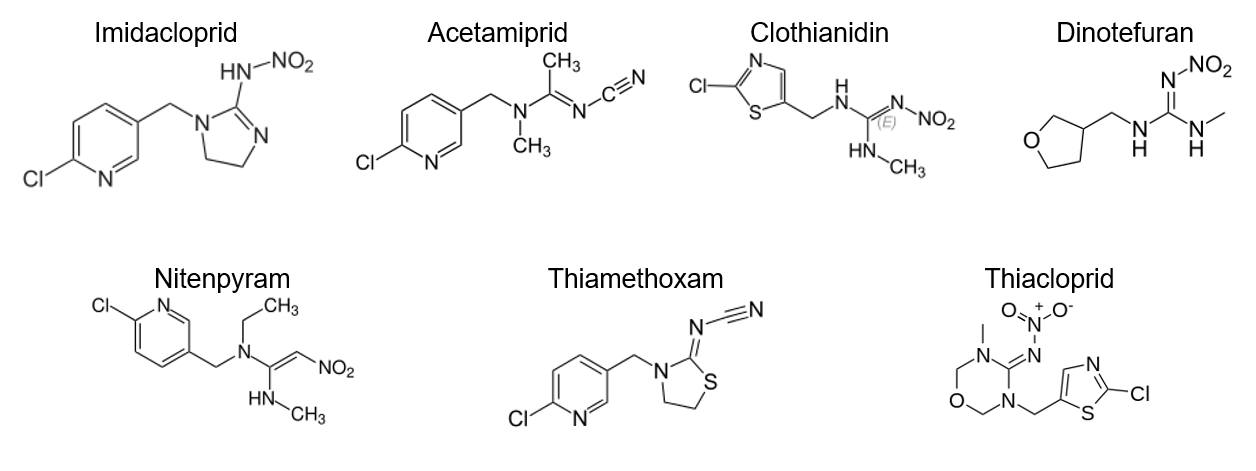Agrochemicals
Neonicotinoids and bees 8th January 2018
By Emilie Branch, Strategic Content Manager, Nice Insight
Emilie Branch, Strategic Content Manager at Nice Insight, considers the impact of neonicotinoids on the health of wild bees. T
 Emilie Branch, Strategic Content Manager at Nice Insight, considers the impact of neonicotinoids on the health of wild bees. The data, including two important field studies conducted in 2017, suggest that numerous factors are leading to reduced resilience of wild bee colonies.
Emilie Branch, Strategic Content Manager at Nice Insight, considers the impact of neonicotinoids on the health of wild bees. The data, including two important field studies conducted in 2017, suggest that numerous factors are leading to reduced resilience of wild bee colonies.The right chemistry for agriculture
One of the challenges in developing effective pesticides is finding compounds with modes of action that are selective for their intended targets and not harmful to humans, other mammals and birds. Neonicotinoids – compounds similar to nicotine – have this property and have become widely used around the world as insecticides.1,2
Like nicotine, neonicotinoids bind to nicotinic acetylcholine receptors (nAChR). Selectivity for insects arises from differences in the structure and composition of the nAChR in insects and mammals; these differences lead to much stronger binding to insect receptors, and thus greater toxicity. The binding is irreversible, resulting in overstimulation and/or blockage of the receptors, paralysis and death. Additionally, some neonicotinoids such as imidacloprid cannot cross the blood-brain barrier in mammals due to the lack of charged nitrogen substituents at physiological pH. Neonicotinoids with negatively charged substituents (nitro and cyano groups) interact with a positively charged amino acid residue in insect nAChR that is not present in mammalian nAChR.
Beyond their generally favourable toxicity profiles, neonicotinoids are also attractive as insecticides because they are water-soluble and have reasonably long half-lives, allowing for long-term protection.
Imidacloprid was the first neonicotinoid insecticide introduced to the market in the mid-1908s (Bayer Crop Science) and is the most widely used. Others include acetamiprid, clothianidin, dinotefuran, nitenpyram, thiacloprid and thiamethoxam.3 These products are effective against sucking (sap-feeding) insects, beetles, fleas, wood boring pests, flies, cockroaches and other insects. They are applied to corn, soybeans, canola, sorghum, cotton, sugar beets, fruit and vegetable crops, and are also found in garden pesticide products and flea/tick prevention products for pets.

Wrong chemistry in the wild, according to lab studies
Since neonicotinoids are used as seed treatments, in soil drenches and sprayed onto foliage and taken up into plants, they are in plant pollen and nectar, and are often detected in flowers, grasses and other plants located near treated fields.3 This has led to concerns about impact on non-target insects, in particular bees and other pollinators.
Laboratory studies suggest that the pesticides are harmful to honey bees at the individual level. A large number of studies agree that neonicotinoids can lead to increased mortality, impaired feeding, foraging and locomotion behaviours, altered learning and memory, and reduced immunity.3 Honey bees have also been shown to prefer sugar water solutions containing neonicotinoids.
However, while lab studies evaluate the effects of pesticides on individual bees, they do not consider that bees live in colonies and are social animals, or that they feed on a variety of plant sources. Effects of living in a colony, the presence of different types of pollen and nectar and the interactions with other pesticides are not addressed, yet these factors may play a vital role in resilience.3
Field studies less clear
Large-scale field studies that investigate the health and behaviour of bees in their natural environment, and account for these factors, provide more relevant information about the impact of neonicotinoids. In field studies reported through 2015, some impacts on individual honey bees were observed, but impacts at the colony level were not.3 It is believed that individual losses may be buffered by the colonies, resulting in no overall loss of performance.
In 2017, the results of two important, large-scale field studies4,5 were published in Science. While many people who believe neonicotinoids should be banned immediately claimed these studies provide evidence that these pesticides are indeed quite harmful to bees, a closer look at the data suggested otherwise. The first article was based on a two-year study funded by Bayer Crop Science and Syngenta and conducted by the UK’s Centre for Ecology and Hydrology (CEH) in three European countries.5 Although the lead CEH researcher Richard Pywell concluded that the study showed negative effects of neonicotinoid-coated seed dressings on honeybees and wild bees, independent reviewers have found no clear conclusions could be drawn, because:6,8
- Only a few of the 258 endpoints collected from 33 different fields were discussed.
- Overall, there was little difference in results observed for untreated and treated fields, and many of the bees in each of the test groups died from other causes before they could be counted.7
- Of the 258 endpoints, 238 showed no effects, 9 showed negative effects, 7 showed positive effects and 4 did not yield any usable data. Notably, it is common with statistical studies that approximately 5% of results are generated randomly – in this case, that would be 13 data points – nearly all the data points that showed negative and positive results (16 total).6
- Results also differed by country. The bees in Germany and Britain preferred canola pollen (nearly 50%), while just about 10% of the pollen picked up by German bees was from canola.8
- A fungal infection killed many of the bees in Hungary, while in England many of the bees were killed by the Varroa destructor mite, including high numbers of the control bees.
The second study was conducted in Canada and designed to study the effects of neonicotinoids on wild honeybees. Bees in apiaries located within 550 yards of treated cornfields were monitored for 5 months, with samples of pollen and honey tested for pesticides. This type of exposure was also replicated under controlled conditions. The researchers found that bees were affected more by pollen containing the pesticides from nearby plants, rather than treated crops. A total of 26 different pesticides were detected, with neonicotinoids below dangerous levels.8
As expected, this study again found that individual bees were affected by neonicotinoids (e.g. worker bees exposed as larva died earlier than those that weren’t exposed). The researchers did not, however, look at colony-level performance indicators, such as fertility, honey production or winter survival rates, which would have provided information about the resiliency of the colonies.8
What is the future for neonicotinoids?
In a third study9 published in October 2017, researchers analysed 198 honey samples from around the world for the presence of five neonicotinoids (acetamiprid, clothianidin, imidacloprid, thiacloprid and thiamethoxam). At least one compound was found in 75% of the samples, while two or more were found in 45%; four or five were detected in 10% – all at levels below the maximum residue level authorized for human consumption. The scientists suggested that these results “confirm the exposure of bees to neonicotinoids in their food throughout the world.”
In Europe, since a ban on clothianidin, imidacloprid and thiamethoxam went into effect in 2014, farmers have been using other pesticides (such as organophosphates) that are more toxic to humans and bees. Canola production is reduced, and the health of bees has not been appreciably affected.7 Farmers in England are using pyrethroid pesticides, compounds with unknown impacts on bees.8 Despite significant questions raised about the real effects of neonicotinoids and the potential for increased use of more harmful chemicals if further bans are put in place, the UK voted in November 2017 to support a permanent, Europe-wide ban on these three neonicotinoid pesticides.10 The European Food Safety Authority (EFSA) is publishing finalized risk assessments on clothianidin, imidacloprid and thiamethoxam in February 2018.11
In the US, the Environmental Protection Agency (EPA) has a schedule for the review of neonicotinoid pesticides.12 Risk assessments for imidacloprid, clothianidin, dinotefuran and thiamethoxam are planned to be completed in 2018, while for acetamiprid finalization is expected by 2019.
What about the bees?
While there are many claims that bees are in sharp decline, not all data support this view.6 In June 2017, Canada reported that its honeybee colonies grew by 10% from 2016 to 2017, concurrent with an increased use of neonicotinoids. In the US, the number of managed beehives is at its highest level in over 20 years (since the introduction of neonicotinoids) after declining from the 1940s to mid-1990s due to urbanization. Furthermore, the number of global bee hives has increased since the 1960s except in the late 1980s when the Varroa mite emerged and in the mid-2000’s in the US during a brief colony collapse disorder outbreak.
It is generally thought that the V. destructor mite is the greatest threat to bee health. The miticides used to control this pest and some bee practices are other important contributing factors.6 Clearly, questions about the impact of neonicotinoids on bee populations remain. By design, as insecticides, neonicotinoids can be toxic to bees. No one has been able to definitively show, however, that exposure to neonicotinoids in the wild is harmful to the extent that these compounds should no longer be used, particularly in light of the properties of the alternatives.
References
1. Jeschke PNR et al. J Agric Food Chem 2011;59:2897-908.
2. Jeschke PNR. Pest Manag Sci 2008;64:1084-98.
3. Cornell University, pollinator.cals.cornell.edu
4. Woodcock BA et al. Science 2017; doi:10.1126/science.aaa1190.
5. Tsvetkov N et al. Science 2017; doi:10.1126/science.aam7470.
6. Entine J. Slate.com, June 2017,
7. Kelland K. Reuters, June 29, 2017.
8. Gallegos J. Washington Post, June 29, 2017.
9. Mitchell EAD et al., Science 2017; doi: 10.1126/science.aan3684.
10. Mehta A. Chemistry World, November 10, 2017.
11. EFSA. Press release, November 14, 2017.
12. EPA. www.epa.gov
Author:
Emilie Branch, Strategic Content Manager, Nice Insight, That’s Nice LLC, 89 Fifth Avenue, Floor 5, Suite 500, New York, NY 10003-3020, USA
T: +1 212 366 4455; E: emilie@thatsnice.com
www.thatsnice.com



